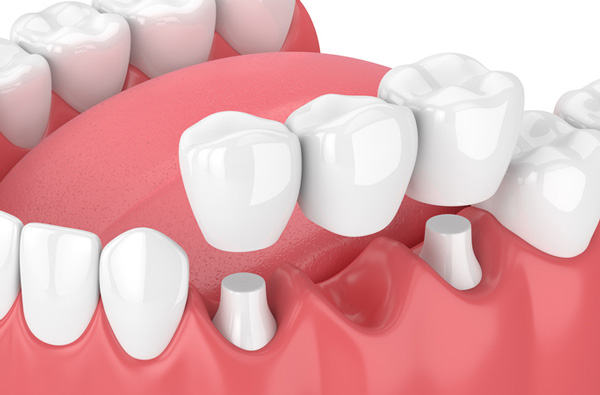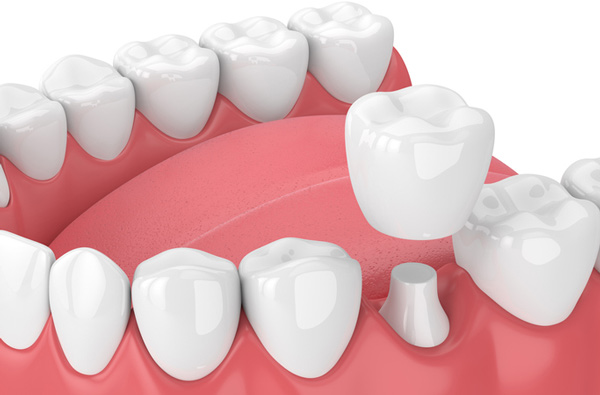Crowns and Bridges Unfortunately, tooth loss is a part of life for millions of Americans. If you are missing one or more teeth, you may be wondering what to do next. At Hammel Dentistry, we specialize in a number of tooth replacement solutions, including dental bridges. Regardless of which restoration you choose, it is important to seek treatment as soon as possible. A missing tooth can lead to more serious complications later down the line. Your remaining teeth may shift out of their proper position to accommodate the open space, leading to a malocclusion, or misalignment in your bite. Unfortunately, tooth loss is a part of life for millions of Americans. If you are missing one or more teeth, you may be wondering what to do next. At Hammel Dentistry, we specialize in a number of tooth replacement solutions, including dental bridges. Regardless of which restoration you choose, it is important to seek treatment as soon as possible. A missing tooth can lead to more serious complications later down the line. Your remaining teeth may shift out of their proper position to accommodate the open space, leading to a malocclusion, or misalignment in your bite.What Is a Dental Bridge?A traditional dental bridge typically consists of two dental crowns linked together by a false tooth, also known as a pontic. This fixed appliance literally “bridges” the gap created by one or more missing teeth, keeping your remaining teeth in their proper position. It will also restore your ability to chew and speak properly, as well as the aesthetics of your smile A dental bridge can also be supported by a series of dental implants. Each implant post serves as the root component of a missing tooth, making implant-supported bridges ideal for multiple missing teeth adjacent to one another. In some cases, we may also suspend a pontic between two implants. Dental Bridge ProcessThe process of receiving a traditional dental bridge is similar to that of a dental crown. The procedure is usually broken down into two appointments: one for preparation and one for placement. During your first appointment, Dr. Kathrine Hammel, DMD will prepare the adjacent teeth, known as abutment teeth, to receive two dental crowns. This means we will completely recontour the enamel to accommodate the shape of the crowns. Once the teeth are reshaped, we will take an impression of the area. The impression is sent to our dental laboratory, where our technicians will use it to fabricate your new restoration. This process typically takes a couple of weeks or so to complete. We may give you a temporary bridge in the meantime to protect your newly reshaped teeth. During your second appointment, we will remove the temporary bridge and place your permanent one. We may need to make some final adjustments to achieve the proper fit. Once we are satisfied, we will secure the bridge in place using special dental cement. Benefits of a Dental BridgeYour new bridge will restore your smile to a more beautiful, aesthetically-pleasing state. Most bridges are fabricated using porcelain or some other ceramic. These materials offer unmatched cosmetic advantages. Ceramic can be color-matched to your remaining teeth, and textured to mimic the appearance of natural enamel. It also possesses the same light-reflective properties as natural enamel. As a result, your new restoration will be virtually indistinguishable from your natural teeth. A bridge also prevents your remaining teeth from shifting out of their proper position, while equally distributing the forces of your bite. If you want to restore your ability to chew and speak properly with a beautiful restoration, a dental bridge may be right for you! Schedule a ConsultationIf you are missing one or more teeth, you may qualify for a dental bridge. Call 520-647-2888 to schedule your consultation appointment now!  At Hammel Dentistry, we offer some restorative treatments designed to prevent you from losing a tooth. One of the most common restorations we provide is known as a dental crown. A dental crown is a tooth-shaped cap that covers a significantly damaged or decayed tooth. You may need a crown to restore a tooth’s size, shape, and appearance. At Hammel Dentistry, we offer some restorative treatments designed to prevent you from losing a tooth. One of the most common restorations we provide is known as a dental crown. A dental crown is a tooth-shaped cap that covers a significantly damaged or decayed tooth. You may need a crown to restore a tooth’s size, shape, and appearance. Reasons You May Need a Dental CrownDental crowns have a number of purposes. We may recommend a dental crown to:
Dental Crown ProcedureThe dental crown procedure is usually broken up into two appointments, although same day crowns are also available. During your first appointment, Dr. Kathrine Hammel, DMD will prepare the tooth by removing a large portion of the enamel (decayed and healthy). The tooth must be completely restructured to accommodate the shape of the dental crown. We may also need to build up the core of the tooth to provide additional support. Once your tooth is in the proper shape, we will take an impression to create a 3D model. The model will be used to fabricate a precise and effective final crown. These days, most crowns are fabricated using porcelain or some other ceramic material. Porcelain possesses the same light-reflective properties as natural enamel, making it virtually indistinguishable from the rest of your teeth. Other crown materials include silver (amalgam), gold, composite resin, zirconia, porcelain-fused-to-metal, and stainless steel. Regardless, the fabrication process generally takes a couple of weeks. In the meantime, we may provide you with a temporary restoration to protect the tooth. Once your final crown is ready, we can schedule your second appointment. During the second appointment, Dr. Kathrine Hammel, DMD will remove the temporary crown. Next, we will place the final crown over the tooth and check the margins. We may need to make some last-minute adjustments to achieve the proper fit. Once we are satisfied with the fit, we will permanently bond the crown to the enamel using special cement. After You Receive a Dental CrownA crown does not require any special treatment beyond a good oral hygiene regimen, and regular checkups and professional cleanings. However, there are certain things you can do to prevent potential damage. Avoid activities that put unnecessary stress on the restoration, such as biting your fingernails and chewing on pen caps. You should also make sure you are brushing and flossing the area properly during your hygiene routine. An antibacterial mouth rinse can also reduce your risk of developing further decay. With the proper care and maintenance, your crown should last between five and 15 years. In some cases, it may even last several decades! Schedule Your AppointmentIf you have a significantly damaged or decayed tooth, you may need a dental crown! Call 520-647-2888 to schedule your appointment today. |
Get in Touch! |